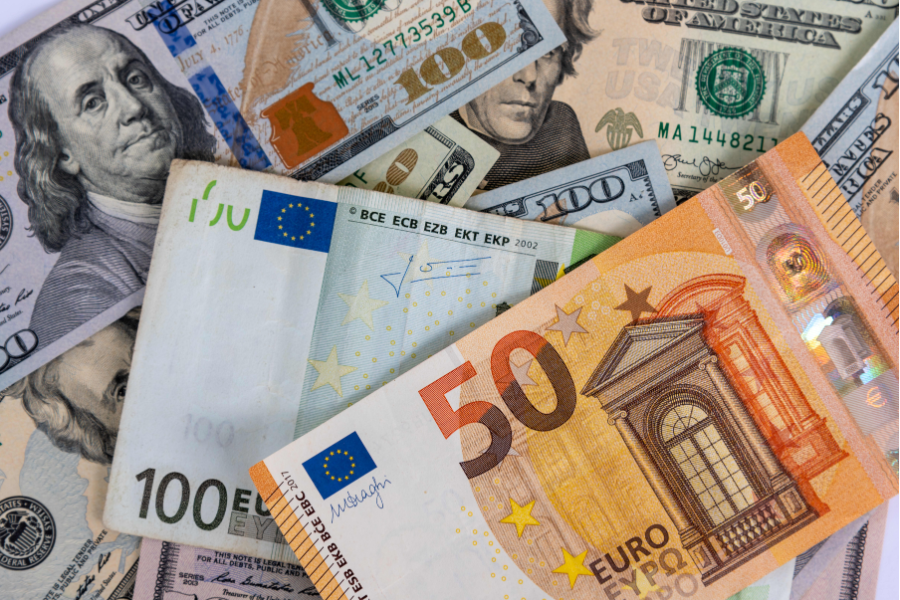Does Europe Prefer SAR Over USD? A Study of Europe’s Currency Choices in International Trade
The impact of currencies on global financial markets plays a crucial role in understanding how economies interact within international commerce. Europe’s stance on whether it favors the Saudi Riyal (SAR) over the US Dollar (USD) requires a closer look at various elements, such as historical trends, political dynamics, economic dependencies, and financial habits. This analysis will explore these aspects and offer insights into Europe’s broader currency preferences, particularly comparing the use of SAR to USD.
The Global Preeminence of the US Dollar
To understand how currency preference operates in global trade, it is necessary to first acknowledge the overarching influence of the US Dollar (USD). The USD has held the title of the world’s leading reserve currency for decades. Not only is it widely used in the United States, but it also serves as the basis for international trade and financial transactions. The USD enjoys favor for several reasons, including its reliability, liquidity, and the confidence that the international market places in the United States’ economic framework.
USD’s Role in Global Trade and Commodity Pricing
The US Dollar’s dominance extends significantly to global commodity markets, particularly in trading essential resources like oil, gold, and precious metals. The majority of transactions involving these commodities are priced in USD, which reinforces the dollar’s central role. European countries, including those within the European Union (EU), regularly interact with USD in their trade and investment dealings, further cementing its global supremacy.
USD as the Leading Reserve Currency
In addition to its widespread use in trade, the US Dollar is also the most common currency held in international reserves. Central banks and financial institutions around the world accumulate significant amounts of USD as part of their foreign exchange reserves. According to the International Monetary Fund (IMF), over 60% of global reserves are in USD, underscoring its status as the preferred currency for international transactions.
The Influence of the US Dollar in Europe
For European businesses, particularly those engaged in international trade or working with US-based entities, the US Dollar is a frequently used currency. Sectors like technology, energy, and manufacturing rely heavily on USD for cross-border payments. In addition, many European financial institutions and investors hold US assets, further reinforcing the dollar’s dominant position within Europe’s financial landscape.
The Euro’s Prominent Role in Europe’s Economy
While the US Dollar has a clear global advantage, the Euro (EUR) is an essential currency, particularly within the EU and surrounding regions. Since its introduction in 1999, the Euro has become the second most traded currency worldwide, outstripping the USD in trade within the European Union, which includes 19 member nations using the Euro as their official currency.
Euro’s Stability and Strength
The Euro is widely regarded as a stable currency, largely due to the economic size and political stability of the Eurozone countries. As a result, the Euro maintains a steady exchange rate against other major currencies, including the US Dollar. Within Europe, the Euro is the preferred currency for transactions, as it avoids the need for conversion and mitigates exchange rate risks.
Euro in Global Trade
Though the Euro is a prominent currency within the EU, its global presence is less extensive compared to the USD. The Euro is the go-to currency for intra-European trade, yet European countries still conduct substantial international business in USD, particularly when engaging with markets outside the Eurozone. This distinction is key to understanding currency preferences in Europe, as it highlights how the Euro’s prominence doesn’t fully overshadow the USD in global trade.
The Saudi Riyal (SAR): A Regional Currency with Limited Global Impact
The Saudi Riyal (SAR), the official currency of Saudi Arabia, plays a significant role within the Middle East due to the country’s economic strength as a major oil exporter. However, its reach on the global stage is more restricted compared to currencies like the USD. The SAR is pegged to the US Dollar at a fixed exchange rate of 3.75 SAR to 1 USD, which stabilizes the currency but also limits its independence and flexibility in global financial markets.
SAR’s Peg to the US Dollar
The SAR’s fixed peg to the US Dollar is a critical feature that defines its role in the global economy. While this peg provides stability for the Riyal, it means that the SAR’s value is directly influenced by fluctuations in the value of the USD. This arrangement, designed to support economic stability in Saudi Arabia—especially considering the nation’s dependence on oil exports priced in USD—limits the SAR’s ability to operate as an independent currency on the global market.
Saudi Arabia’s Economic Influence and the SAR’s Global Presence
Despite the Saudi Riyal’s importance within Saudi Arabia, particularly for transactions tied to oil exports, it has minimal influence beyond the Middle East. In contrast, the US Dollar is universally used across various sectors of global trade. Although Saudi Arabia conducts much of its trade in USD, the SAR’s role is largely confined to domestic transactions within the Kingdom.
International Trade and Investment in Saudi Arabia
When European companies engage in trade with Saudi Arabia, they typically use the US Dollar for transactions, as it is the dominant currency in international oil markets. The limited use of the SAR beyond the borders of Saudi Arabia means that European firms, even when working with companies in Saudi Arabia, often prefer to settle deals in USD for compatibility in global trade.
The Role of the Saudi Riyal in European Markets
Within Europe, the Saudi Riyal sees very little use as a currency for trade or financial exchanges. Unlike the Euro or the US Dollar, the SAR is not commonly utilized outside the Gulf region. However, businesses and financial institutions with ties to the Saudi economy may still handle SAR in specific contexts, particularly in energy-related sectors or through partnerships with companies in Saudi Arabia.
Currency Exchange Services in Europe
Banks and financial institutions in Europe, especially those with operations in the Middle East, may offer exchange services for the Saudi Riyal. However, the volume of SAR transactions is much lower compared to more widely used currencies like the Euro or USD. Given that the SAR is pegged to the USD, European businesses dealing with Saudi Arabia typically use USD in their transactions, as it is more widely accepted and liquid in global markets.
Investment and Trade Connections Between Europe and Saudi Arabia
While European investment in Saudi Arabia may require dealings in SAR, this does not imply a preference for the Riyal over the Euro or the USD. Businesses with operations in Saudi Arabia may be compelled to use the local currency for certain transactions, but on a global scale, the SAR’s role remains peripheral in Europe’s economic activities.
Geopolitical and Economic Influences on Currency Preferences
The political and economic dynamics between Europe, the US, and Saudi Arabia further shape currency preferences. Historically, the US has been a key ally to many European countries, bolstering the role of the US Dollar in trade, defense, and political cooperation. On the other hand, while Saudi Arabia maintains important energy-related ties with Europe, these connections have not translated into a widespread adoption of the Saudi Riyal in European financial markets.
Oil and Energy Trade as a Driver for Currency Preference
The oil market plays a pivotal role in determining currency preferences. Since Saudi Arabia is one of the largest oil producers globally, European nations importing Saudi oil typically settle transactions in USD. Despite Saudi Arabia’s economic diversification efforts, oil remains central to its financial system, and the USD’s dominance in the energy sector reinforces its role in European and global trade.
Saudi Arabia’s Economic Diversification and the Future of the SAR
In recent years, Saudi Arabia has been pursuing economic diversification through initiatives like Vision 2030, aiming to reduce the country’s reliance on oil exports. However, despite these efforts, the SAR is unlikely to surpass the USD or Euro in terms of global trade significance. The SAR will likely remain a regional currency with limited influence outside the Middle East.
Economic Considerations for European Businesses
For businesses in Europe, understanding the role of different currencies is vital, particularly when engaging in cross-border trade or investment. The US Dollar and Euro remain at the forefront of international commerce, while the Saudi Riyal’s impact is confined to regional activities. While European companies working with Saudi Arabia may need to manage transactions in SAR, this does not suggest a broad preference for the Riyal over the USD or Euro in the global marketplace. The stability and global reach of the US Dollar make it the preferred choice for European businesses in international trade.
Key Facts
- Dominance of the US Dollar:
The US Dollar (USD) remains the world’s primary reserve currency, widely used in global trade, investments, and financial reserves. Over 60% of global foreign exchange reserves are held in USD, underscoring its dominance. - The Role of the Saudi Riyal (SAR):
The Saudi Riyal (SAR) is pegged to the US Dollar at a fixed rate of 3.75 SAR to 1 USD. This peg provides stability but limits the Riyal’s flexibility in the global currency market, meaning it is not widely used outside of Saudi Arabia. - Euro’s Significance in Europe:
The Euro is the second most traded currency globally and plays a crucial role within Europe, especially for intra-EU transactions. However, in global trade outside of the EU, the US Dollar continues to take precedence, even among European countries. - Euro and US Dollar in International Trade:
Although the Euro is heavily used within the EU, European countries still conduct significant portions of their international trade in USD, especially when dealing with non-Eurozone countries. The US Dollar is particularly dominant in commodity markets like oil and gold. - European Businesses and the US Dollar:
European companies, especially those engaged in multinational trade or industries like technology and energy, frequently use the USD for cross-border transactions. The liquidity and stability of the USD make it the preferred currency for international business. - Limited Use of the Saudi Riyal in Europe:
Despite Saudi Arabia’s significant role in global oil exports, the Saudi Riyal is rarely used in Europe. European businesses conducting transactions in Saudi Arabia may deal in SAR for domestic business, but for international transactions, they still prefer USD due to its broader acceptance and liquidity. - Geopolitical Relationships and Currency Preferences:
Europe’s historical and economic ties with the US have further solidified the use of the US Dollar. While Saudi Arabia is a key energy partner for Europe, its economic influence does not extend to making the SAR a preferred currency in European trade. - Economic Diversification in Saudi Arabia:
Saudi Arabia’s Vision 2030 initiative aims to reduce the country’s dependency on oil, but despite these efforts, the SAR is unlikely to surpass the USD or Euro in terms of international trade usage. - Currency Peg Impact:
The SAR’s fixed peg to the US Dollar limits its independent movement in the international currency markets, meaning that even though Saudi Arabia is a major global oil exporter, its currency does not exert significant influence outside its region.
Conclusion: Does Europe Prefer SAR Over USD?
To conclude, Europe does not favor the Saudi Riyal (SAR) over the US Dollar (USD). While the SAR holds regional importance within Saudi Arabia and the Middle East, its impact on the global financial scene is limited. The US Dollar, by contrast, remains the dominant currency in global trade, investments, and foreign reserves. Europe’s close economic ties with the US, combined with the Euro’s prominence in the region, ensure that the USD continues to be the primary currency for international transactions. Despite efforts to diversify Saudi Arabia’s economy, the SAR’s global reach remains confined, and its peg to the USD further strengthens the dollar’s role in Europe and around the world.
Frequently Asked Questions
- Does Europe use the Saudi Riyal (SAR) in trade?
No, Europe typically uses the US Dollar (USD) in trade, even with Saudi Arabia. Although some transactions within Saudi Arabia are conducted in SAR, European businesses predominantly use USD for international dealings. - Why is the US Dollar preferred over the Saudi Riyal in Europe?
The US Dollar is the world’s primary reserve currency, known for its liquidity, stability, and global reach. Its widespread use in international trade, especially for commodities like oil, solidifies its preference in Europe and beyond. - Is the Saudi Riyal (SAR) pegged to the US Dollar?
Yes, the Saudi Riyal is pegged to the US Dollar at a fixed rate of 3.75 SAR to 1 USD. This peg offers stability but restricts the Riyal’s flexibility in global markets. - Can European businesses conduct transactions in SAR?
While European companies may engage in transactions in SAR within Saudi Arabia, they generally prefer USD for international trade due to its global acceptance and liquidity. - Will the Saudi Riyal replace the US Dollar or Euro in global trade?
Unlikely. Despite Saudi Arabia’s efforts to diversify its economy, the SAR will likely remain a regional currency. The US Dollar and Euro continue to dominate global trade, with the SAR’s peg to the USD reinforcing this trend.
Stay updated with the latest news and trends here at My Reading Manga!







